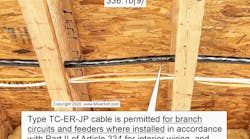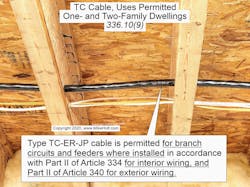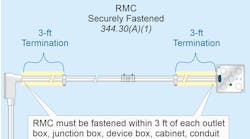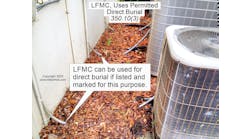Courtesy of www.MikeHolt.com
All questions and answers are based on the 2023 NEC.
Q: What are the conditions TC cable can be used and installed?
Type TC cable is permitted to be used:
(1) For power, lighting, control, and signaling circuits.
(2) In cable trays including those with mechanically discontinuous segments up to 1 ft.
(3) In raceways.
(4) In outdoor locations supported by a messenger wire.
(5) For Class 1 circuits in accordance with Art. 725.
(7) Between a cable tray and equipment if it complies with Sec. 336(10)(7).
(8) In wet locations where the cable is resistant to moisture and corrosive agents.
(9) In one- and two-family dwellings, Type TC-ER-JP cable is permitted for branch circuits and feeders where installed in accordance with Part II of Art. 334 for interior wiring, and Part II of Art. 340 for exterior wiring (see Figure).
Exception: Where Type TC cable is used to connect a generator and its associated equipment, the cable ampacity limitations of Sec. 334.80 and Sec. 340.80 do not apply.
Author’s Comment: The “ER” marking on Type TC-ER cable identifies it as suitable for exposed run use in accordance with UL. The “JP” marking on Type TC-ER-JP cable identifies it as suitable to be pulled through wood framing members because the cable has met the joist pull testing requirements of UL.
(10) Direct buried where identified for direct burial.
Q: Under what conditions can TC cable not be used and installed?
Type TC cables are not permitted:
(1) Where exposed to physical damage.
(2) Outside a raceway or cable tray system, except as permitted in Sec. 336.10(4), Sec. 336.10(7), Sec. 336.10(9), and Sec. 336.10(10).
(3) Exposed to the direct rays of the sun, unless identified as sunlight resistant.
Q: How much can you bend TC cable?
(1) Four times the overall diameter for cables 1 in. or less in diameter.
(2) Five times the overall diameter for cables larger than 1 in. but not more than 2 in. in diameter.
These materials are provided by Mike Holt Enterprises in Leesburg, Fla. To view Code training materials offered by this company, visit www.mikeholt.com/code.






